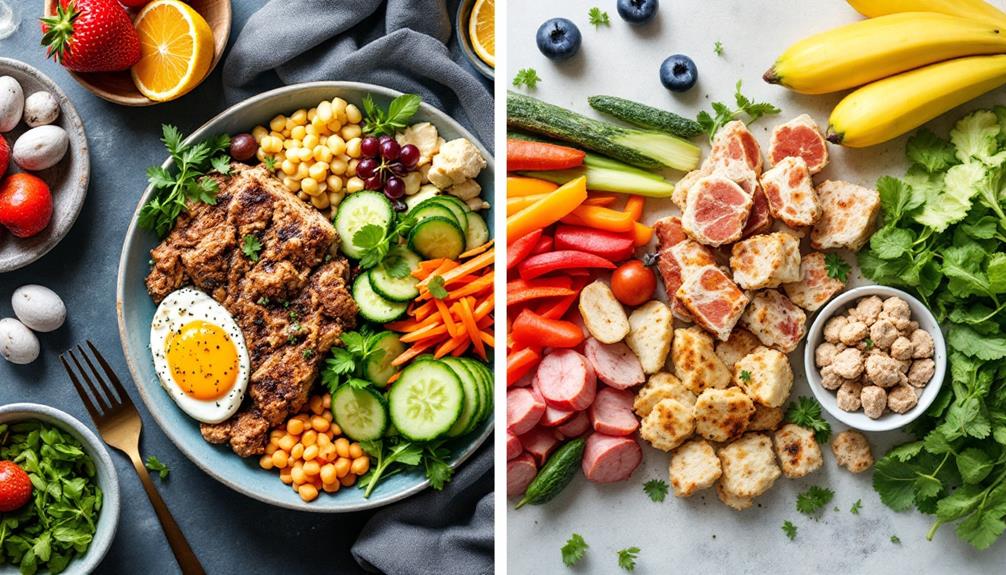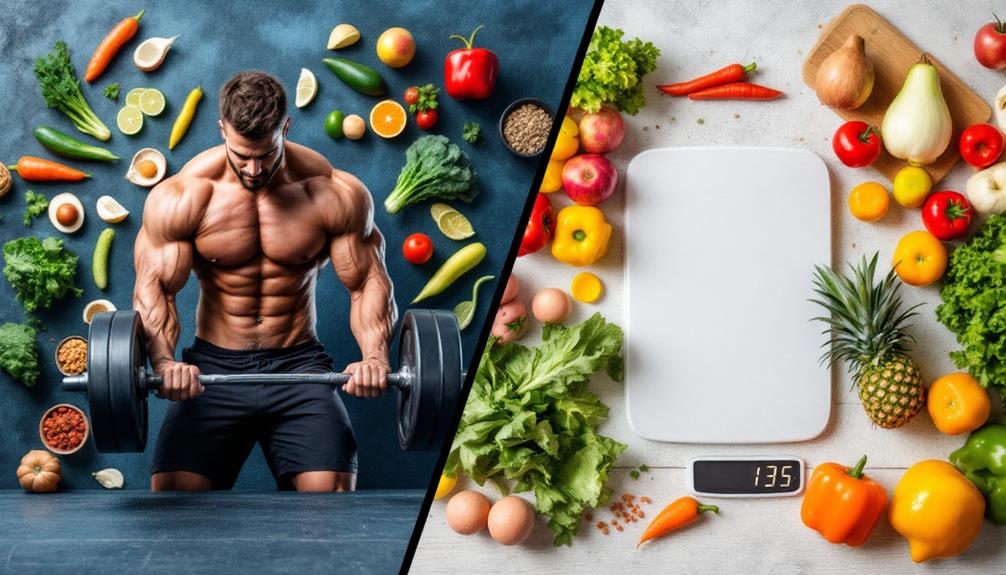Bulking vs. Cutting: Key Differences
When you're bulking, your goal is to gain muscle, so you'll eat more calories with a focus on good carbs, proteins, and healthy fats. In contrast, cutting aims to lose body fat while maintaining muscle, requiring fewer calories and higher protein intake. Nutritionally, bulking means more frequent meals, while you might try intermittent fasting when cutting. Training also differs: bulking usually involves heavier weights, whereas cutting emphasizes higher repetitions and cardio. Understanding these differences helps you achieve your fitness goals. Stick around to explore how to best tailor these strategies to your needs.
Core Insight
- Bulking involves consuming more calories to build muscle, while cutting focuses on reducing calories to lose body fat.
- Nutritional strategies differ: bulking emphasizes good carbs and healthy fats, whereas cutting prioritizes protein and limits carbs.
- Meal timing varies; bulking typically includes more meals, while cutting may utilize intermittent fasting.
- Training approaches change: bulking often uses lower reps with heavier weights, and cutting employs higher reps with moderate weights.
- Hydration is crucial; during cutting, individuals need to monitor water retention, while bulking generally promotes adequate hydration for muscle growth.
Purpose of Each Phase

When you dive into fitness, it's important to understand bulking and cutting if you want to reach your goals. Following a clean bulking food plan can help you gain muscle while keeping excess fat to a minimum during the bulking phase.
Purpose of Bulking
Bulking is all about gaining muscle. You eat more calories to give your body the energy it needs to build new muscle. This phase helps you add size, making it easier to reach your strength goals.
Purpose of Cutting
Cutting focuses on losing body fat. You eat fewer calories while trying to keep the muscle you've built. This phase helps you achieve a leaner look, making your hard-earned muscle more visible.
Knowing the purpose of each phase will help you make better choices in your training and nutrition, keeping you on track to reach your desired results.
Nutritional Strategies

To successfully bulk and cut, you need to follow some basic nutrition guidelines. Here's a simple way to manage your diet:
- Bulking: Aim to eat more calories than you burn. Focus on good carbs, lean proteins, and healthy fats. You might want to use clean carb powders to help build muscle and keep your energy up for tough workouts.
- Cutting: Eat fewer calories by focusing on protein while cutting back on carbs and fats. This will help you keep your muscle while losing fat.
- Meal Timing: When bulking, try to eat more meals throughout the day to support your workouts. If you're cutting, you might benefit from intermittent fasting to help control hunger.
- Hydration: Drink plenty of water in both phases, but watch out for water retention when you're cutting.
Training Approaches

When you're cutting, use higher repetitions with moderate weights. This helps you keep your muscles while burning fat. Adding cardio sessions will help you burn more calories and improve your results. If you're looking for safe ways to gain muscle, consider supplements that aid muscle recovery and support protein synthesis, based on your fitness goals. Make sure your workout plan matches your goals. Changing your training intensity, volume, and frequency can really impact your progress and help you stay on track.
Frequently Asked Questions
How Long Should Each Phase Typically Last?
Typically, each phase lasts about 8 to 12 weeks. You should monitor your progress and adjust as needed, ensuring you're achieving your goals effectively without compromising your health or overall fitness long-term.
Can I Switch Between Bulking and Cutting Phases?
Yes, you can switch between bulking and cutting phases. Just be mindful of your goals, listen to your body, and adjust your nutrition and training accordingly. Consistency and patience are key for best results.
Are Supplements Necessary During Bulking or Cutting?
Think of supplements like the extra fuel for a race; they're not essential, but they can enhance your performance. You can achieve results without them, but they might help you reach your goals faster.
What Are Common Mistakes to Avoid in Each Phase?
When you're in either phase, avoid extreme calorie changes, neglecting macronutrient balance, and skipping workouts. Stay consistent with your training and nutrition, and don't forget to track your progress to make necessary adjustments.
How Do Body Types Affect Bulking and Cutting Strategies?
When it comes to body types, you've gotta know that one size doesn't fit all. Your unique physique influences how you should approach bulking and cutting, determining calorie intake, workout intensity, and recovery strategies.

